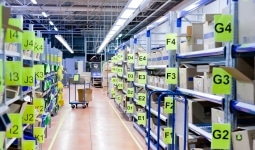Maintenance, repair, and operations stockrooms are no different than consumer product inventory systems, they should be built and managed to solve “customer” problems. Stockrooms “customers” are a company’s internal departments of course – production, finance, procurement, etc. In fact, because MRO influences how well so many other departments function, stockroom organization methods play a critical role in a company’s profitability. Space utilization, speed and accuracy in fulfillment, being prepared for scheduled and unscheduled repairs, and following a standardized routine all contribute to a well-run and well-operated storeroom.
Why Stockroom Organization Matters
Any time production stops, your company loses potential profit. When that stoppage is unplanned, the costs increase exponentially. Getting back up and running becomes job number one. Wasting time looking for a replacement part that’s not where the record says it should be unnecessarily subtracts from the bottom line. The only thing worse is finding out the part isn’t even on-site because poor storeroom management methods allowed the reorder to slip through the cracks.
A well-thought-out design, intuitive organization, the right equipment, and regulated organization procedures can bring any company several real benefits:
- Faster maintenance and repair times – When everything is in its place, technicians can find, kit, and transport necessary parts and consumables to the line in advance of scheduled maintenance or at the first sign of unanticipated breakdowns. They can start repairs more quickly and get production going again. SDI offers storeroom technology to simplify parts tracking for fastest possible repair times.
- Inventory reduction – Ensuring each part is stored in a specific, central location. Preventing workers from squirreling away a personal stock of commonly used parts makes inventory simpler. The company will get a truer picture of inventory levels and eliminate duplication of parts so reorders can be made on time.
- More space – Less inventory means you won’t need as much room to store it all. Even better, strong stockroom organization methods optimize space by discerning the best ways to handle parts – whether on shelves, in bins, or in cabinets. The space saved could be converted into additional manufacturing capacity, an inventory staging area, workspace for repairs and maintenance kitting, or other value-added purposes.
- Fewer stockouts – Knowing each critical part has a working spare in the stockroom gives organizations peace of mind and assures uninterrupted production. It also means the company can save money by avoiding rush orders, overnight freight charges, duplicate orders, and other costs that come with not knowing exactly where and which parts are in the storeroom.
Stockroom Organization Ideas for Space and Efficiency
A well-organized and well-managed stockroom resides at the intersection of MRO strategy and implementation. It takes both workflow analysis and the right tools to get the job done correctly. Organizations that are serious about transforming their stockrooms into sources of competitive advantage can implement these best practices:
- Form follows function – Workflow, access, and production priorities should drive stockroom organization design. Carefully measure to ensure hand trucks and other material-moving equipment can maneuver freely while not wasting space with overly wide aisles. Classify parts according to standard metrics. Place the most critical parts, the ones with the longest replacement lead time, and those used most frequently where they can be picked and deployed most rapidly.
- Birds of a feather – Keep similar parts in the same neighborhood. This is especially helpful if non-stockroom employees will be self-filling their needs for common parts such as bolts, caskets, cleaning supplies, etc. Take this tip a step further by grouping items that are commonly used together, such as all the common replacements for a particular machine.
- Rack up the hardware – Rugged racks, right-sized storage bins, and other storage units make the best use of a storeroom’s available space. Store small, loose objects in open bins for easy access. Large, heavy items should go on heavy-duty racks both as a safety precaution and to allow forklifts to the ability pick them up quickly and properly. Hardy rack systems also can increase the room’s capacity by adding shelves vertically. And, don’t forget lockable cabinets to discourage pilfering of high-dollar components.
- Taxonomy and labeling – Help employees to find what they are looking for by making the stockroom easy to navigate. Organize and name aisles, racks, shelves, and other storage units logically and clearly. Keep a master list of materials and their locations; cross reference the list alphabetically, by part type, equipment bill of materials, and any other method that makes sense for your employees and your company.
- Make room for people – Stockroom organization can help maintenance personnel work more proactively. Companies can use some of the space they save from employing the above methods to install worktables where workers can refurbish parts, repack bearings, as well as kit out parts and materials. Kitting especially can achieve higher level results by integrating with planned and predictive maintenance to keep downtime to a minimum. Maintenance professionals can prepack the manuals, parts, and tools that they will need before a scheduled production line shutdown. They can stage larger parts on the lineside to avoid delivery delays.
Outsourcing Storeroom Organization
Stockroom organization for maximum efficiency requires effort and resources that firms may not have available in-house. SDI possesses the experience in storeroom management and processes to optimize any company’s storeroom space, design, and workflow. To find out how SDI can help your stockroom deliver the service its internal customers require to perform at their best, contact our industry experts today.





